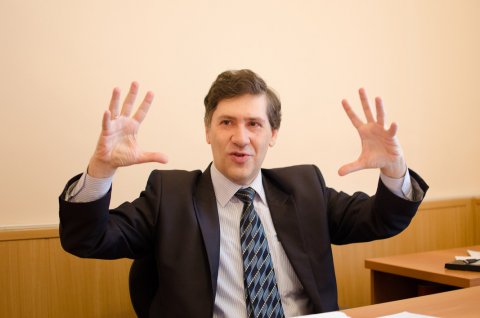The universe, now and always, has fascinated humankind with its mystique and unexplored territories. We look at the starry sky and see many stars thousands or millions of lightyears away from us. The universe lives by its own, not fully understood laws.
At South Ural State University, candidate of physical and mathematical sciences, assistant professor of the department of physical electronics of the Institute of Humanitarian and Hard Sciences, Igor Klebanov, is studies of the mathematical models of the universe’s large-scale structures.
Igor Iosifovich has been working in the department of physical electronics since 2005. His scientific specialty is mathematical physics and applied mathematics. Beyond his scientific work, Igor Klebanov leads courses in mathematical modeling for the faculty’s bachelor’s and master’s students.
The researcher says that his scientific career began with theoretical physics, but his path then moved towards applied mathematics and mathematical physics, especially mathematic models of the movement of self-gravitating gases. The researcher explains this term as follows:
“Imagine a cosmos filled with gas. From this gas, stars and star systems are formed. And now imagine galaxies, which can be considered particles of gas, the movement of which comes from gravity. There is a certain logic to the distribution of the galaxies in the universe, which we call a large-scale structure. This describes the fairly complex system of differential equations which mathematics studies,” explains Igor Iosifovich.
The researcher is working on group analysis of differential equations. To explain what this means to our readers, Igor Iosifovich cites the words of our old colleague, Nail Ibragimov, professor emeritus of the Blekinge Institute of Technology, leader of the area of group analysis in Russia: “Group analysis is the microscope of mathematic simulation.”
Imagine that you have some object and you can’t see all of its components. If you placed it under this “microscope”, you’d be able to see much more detail.
“If we have a mathematical model, then group analysis allows us to examine it, figuratively speaking, under a microscope, and see the solutions we would otherwise not see. For this we need to find all the transformations of the dependent and independent variables without changing the form of the equation. These are called symmetries,” says the candidate of physical and mathematical sciences.
“I calculated all of the symmetries of the studied system of model equations called Newton’s Cosmology and found new solutions, and also established the theoretical group-nature of a few well-known solutions,” says the researcher.
One of such solutions was published in the journal Communications in Nonlinear Science and Numerical Simulation. It is among the top 10% of journals of the international system Web of Science and has an impact factor of 2.8.
.jpg)
South Ural region researchers saw that the theoretical-group nature follows the well-known Hubble’s law, which describes the expansion of the universe. This law has been known for a long time, but only they were able to determine that this law is just one of the possible solutions. There are two more alternative models for the expansion of the universe, which can be checked using astrophysical observation. Of course, this is very difficult.
“It turns out that the universe can behave quite differently. That is, although Hubble’s law conforms with today’s astrophysical observations, when the universe expands like a “ball” (this is called spherical-symmetrical expansion), the movement can have some fine characteristics which are not included in Hubble’s law. This can be experimentally verified through observations of distant objects,” says Igor Iosifovich.
The difficulty of this experiment is that such research can only be carried out by a large group of astrophysicists, and the objects under observation are very distant.
«My task, as a pure theoretician, is only to study the mathematical model. It is difficultto say what this will develop into and how it may help humankind,” says Igor Klebanov.
As Igor Iosifovich jokes, Michael Faraday was also asked what benefit electricity would have for humankind. He answered, “I don’t know what benefit it will have, but someday they’ll introduce a new tax on it.” Nowadays, we can’t imagine the world without this discovery.
Right now, researchers are not able to say how their research will be applied practically. But Igor Iosifovich is sure that our descendants will be able to find its application:
“At the very least, study of the universe is beautiful. It has a direct relationship to mathematics, astrophysics, and cosmology, and we will see what its practical application will be.”
Information:
1. Newton Cosmology is a model for the structure of the universe, in which it was all-encompassing and endless in absolute space and time. In such a universe, only concrete cosmic systems change, but not the “world as a whole”.
2. Hubble’s law (the law of cosmic scatter) is a cosmological law describing the universe’s expansion.




